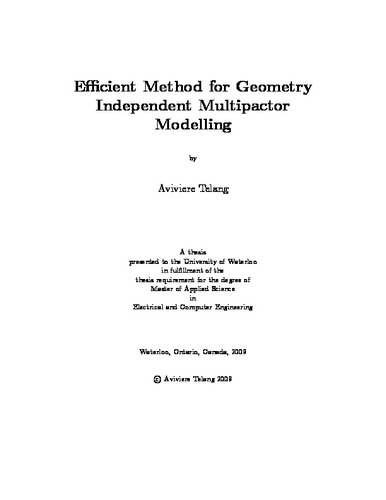| dc.contributor.author | Telang, Aviviere | |
| dc.date.accessioned | 2009-05-20 18:03:00 (GMT) | |
| dc.date.available | 2009-05-20 18:03:00 (GMT) | |
| dc.date.issued | 2009-05-20T18:03:00Z | |
| dc.date.submitted | 2009 | |
| dc.identifier.uri | http://hdl.handle.net/10012/4428 | |
| dc.description.abstract | As modern satellite communication systems move toward multi-carrier high power communications, there is an increased need for high-power RF devices in the space industry. However, at high-power some RF devices have exhibited an electron plasma (multipactor electron avalanche discharge) that severely damages the RF device and could render it unusable. This is especially a problem in space where repairs to communication equipment is cost-prohibitive.
As a result, a number of models have been developed in recent years to predict the onset of multipactor discharge. However, most existing models can only analyze selected geometries and they also require a large number of electrons to predict the power at which multipactor discharge will occur. This has placed a limitation on the types of RF structures that can be analysed for multipactor breakdown.
This research work, uses a new generalized procedure to develop an efficient multipactor model that could be used to analyze the complex structures found in the commercial space industry, by coupling EM field information from established industry-standard EM solvers. A robust secondary emission model is also developed in order to model the advanced phenomenological characteristics of secondary emission that are not taken into account in other models. The result of the generalized approach taken in this research is a highly efficient multipactor model that requires far fewer electrons to be analysed in order to converge to accurate results, and the ability to analyse more complex RF structures than current models.
Multipactor analysis for different structures were performed, and the breakdown results predicted by this model were in good agreement with other models where expected. However, for other cases where certain simplifying assumptions do not hold true, such as higher order waveguide multipaction and high impedance transmission line multipaction, results provided by this model were found to be more accurate and efficient when compared to other models. | en |
| dc.language.iso | en | en |
| dc.publisher | University of Waterloo | en |
| dc.subject | Mutipactor | en |
| dc.subject | Multipaction | en |
| dc.subject | Multipact | en |
| dc.subject | High Power Breakdown | en |
| dc.subject | Microwave | en |
| dc.subject | Breakdown | en |
| dc.title | Efficient Method for Geometry Independent Multipactor Modelling | en |
| dc.type | Master Thesis | en |
| dc.pending | false | en |
| dc.subject.program | Electrical and Computer Engineering | en |
| uws-etd.degree.department | Electrical and Computer Engineering | en |
| uws-etd.degree | Master of Applied Science | en |
| uws.typeOfResource | Text | en |
| uws.peerReviewStatus | Unreviewed | en |
| uws.scholarLevel | Graduate | en |

